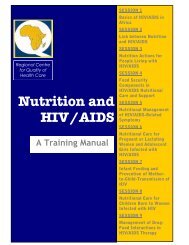2.1: Anthropometric Indicators Measurement Guide - Linkages Project
2.1: Anthropometric Indicators Measurement Guide - Linkages Project
2.1: Anthropometric Indicators Measurement Guide - Linkages Project
You also want an ePaper? Increase the reach of your titles
YUMPU automatically turns print PDFs into web optimized ePapers that Google loves.
APPENDIX<br />
of<br />
<strong>Anthropometric</strong><br />
6.Standardization<br />
<strong>Measurement</strong>s<br />
The training of personnel on specific<br />
measurement and recording techniques<br />
includes not only theoretical explanations<br />
and demonstrations, but also an<br />
opportunity to allow participants to<br />
practice the measurement techniques, as<br />
well as reading and recording the results.<br />
This practice is more efficient when a<br />
large number of children are available.<br />
9.<br />
Once all personnel have adequately<br />
practiced the measurement and recording<br />
techniques, and feel comfortable with<br />
their performance, standardization<br />
exercises can be carried out. Each<br />
exercise is performed with a group of 10<br />
children whose ages fall within the preestablished<br />
range for the study. A<br />
sequential identification number is<br />
assigned to both children and staff. To<br />
conduct the exercises the following are<br />
needed:<br />
balances/scales and height boards;<br />
pens; and<br />
•<br />
sufficient <strong>Anthropometric</strong> Standardization<br />
Forms 1 and 2, to record the<br />
exercise number, name and number of the<br />
measurer, date on which the exercise is<br />
conducted, and a sequential listing of<br />
children with their name, age and<br />
identification number.<br />
82

















